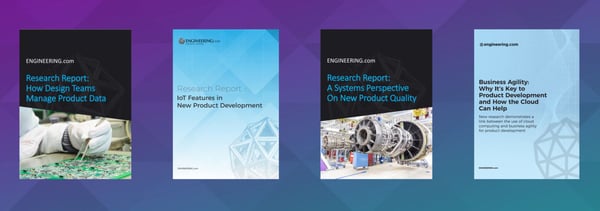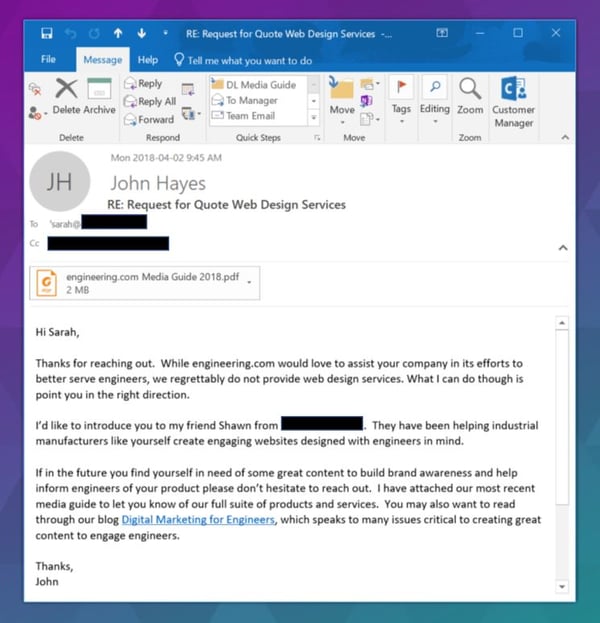 Engineers are remarkably adept at keeping a high signal to noise ratio in their inbox. Content that isn’t constantly delivering value is aggressively re-routed to unseen folders like Gmail’s Social Updates or Outlook’s Other.
Engineers are remarkably adept at keeping a high signal to noise ratio in their inbox. Content that isn’t constantly delivering value is aggressively re-routed to unseen folders like Gmail’s Social Updates or Outlook’s Other.
Even worse, they may delete it on sight, or even mark it as spam, thereby blocking you off and dinging your list’s credibility.
This is terrible news for marketers.
If you spend days and weeks getting your editorial calendar just right, identifying the right authors within your organization, pleading with them to finish their posts, and then proudly packaging their stories into a company e-newsletter, this is devastating news.
Although it isn’t really news, is it? You already know from your email open rates and CTRs that engineers are filtering out your messages.
So what’s the answer? Does the path to higher engagement lie with better content or better distribution? It’s both, of course. In this post we’ll explore what better content means when it comes to reaching engineers. We’ll save the distribution topic for another time.
These insights are based on how we make sure that engineers read/watch or listen to content from engineering.com, where our content reaches over 2.3 million engineers every month.
Step One: Selecting the Right Topic is by Far the Most Important Step
Selecting the right topic to engage engineers is by far the most important part of content creation, so I can’t stress enough how important it is to spend the extra time to get this right. All too often we see marketers rush into this part of the project because they have a pressing deadline and just need something, anything, to drive traffic and/or leads.
This is the worst spot to find yourself. One way to avoid the time-crunch trap is to routinely spend time with your sales engineers, whether over lunch, at company events, or setting a specific meeting. Your goal is to find out for yourself, first hand, why customers are considering your products. So often marketers are satisfied to say that their product works well for a series of applications without really understanding the perspective of the engineer at your customers’ sites.
 (Research, research, research!)
(Research, research, research!)
Let me provide an example of how our writing team tackles this challenge when a client asks us for a story. Before we meet with a sales engineer from the client, we start by reviewing their web site, using tools like SEMrush to see what keywords are associated with their products, and comb sites like Quora to see what questions are being asked. We then prepare a list of questions for the client’s sales engineers.
You can do the same kind of research to build out questions for meetings with your own sales engineers. Also, be sure to check your Google Analytics, Google Search Console, or Content Management System to learn what landing pages are being visited or ignored, and the search strings that drove traffic to those pages. This information is excellent for generating hypotheses about your customers that your sales engineers can either confirm or dispel.
Marketers have to understand, at a very fundamental level, how customers use their solutions
Once we have a sense of both the product and the prospective customers’ feelings about the product / product category / industry we’re set to meet with an engineer. For example, let’s say for the sake of illustrating the point, that our client’s company makes small collaborative robots, and we know that they are gaining adoption for packaging applications. To really understand what that means, our staff gets deep into some representative customer’s use cases to understand:
- What is the customer packaging? How big or small are the items, and how many to a package?
- What did the packaging line look like before and after (pictures are very helpful here)?
- How did the end user’s employees work before they implemented the robot?
- How much did it cost to package the old way?
- What was the total cost, including 3rd party services, to implement our client’s solution?
- What was the internal process to buy the robot? What was the trigger, and who had to sign off?
The answers to these questions, however dull and detailed, will yield a cache of information that brings us a big step closer to understanding how the product really works in the field. And that brings us a big step closer to selecting a killer topic for an excellent piece of marketing content.
 (when picking the best ideas post-it notes are a great way to see everything at once)
(when picking the best ideas post-it notes are a great way to see everything at once)
Once you have done this work, you can decide what content topics will work best. We’d do this during an editorial meeting, but you can achieve similar results by holding a round-table with fellow marketers and sales team members. The goal is to muster the wisdom of the crowd. Continuing with the example of our outsourced piece of content, our writer’s will float a number of ideas with their colleagues and manager, generating ideas based on their findings:
- Were the customers surprised to find out how easy/economical it was to justify a robot for packaging? If so, a piece like, “Why Every Packaging Line Now Needs a Robot” should resonate with the target audience.
- Were the end users concerned about recruiting labor in an era of 4% unemployment? If so, perhaps a case study on “Packaging Line Turns to Low-Cost Robots in Tight Labor Market,” would set the right tone.
- Or maybe the engineers struggled to find the cost justification for buying their first robot. In that case, a detailed ROI analysis would be useful, with a title like, “How to Prove ROI on Your First Robot for Packaging”
There will be dozens of story ideas that come out of this work, whether done by an outsourced team or by your own team internally. You should consider them all. Among the ideas that aren’t chosen for this piece you’re currently working on will be a handful of great ideas. Be sure to revisit your list once you’ve wrapped your currently project. After all, content marketing isn’t about having a single great piece of content – it takes dozens of carefully crafted pieces over a period of years.
Step Two: Making Your Content Piece Truly Useful to Engineers
The bar is high. To capture the attention of engineers, you need to create a piece of content that is truly useful. It literally has to save the engineer time, tell them something they don’t already know, and it has to be authoritative.
If you are considering a piece with research that is limited to Google searches, then don’t be surprised to find that your content doesn’t travel. But if you really dig into the topic and deliver the most informative piece on the Internet on the subject, you will be rewarded.
How can you deliver such a valuable piece of content? There are several possible ways.
One way is to survey your customers to find out how they are using your product and what results they are getting. You can use survey tools such as SurveyMonkey to analyze the data, which you can then share with your audience. This ensures that your results are objective and authoritative. After all, it’s not your company saying that your solution provides great benefits, it’s other engineers. At engineering.com we conducted 8 surveys on behalf of our clients last year and all were well received by our engineering audience.
 (A handful of engineering.com research reports from 2017)
(A handful of engineering.com research reports from 2017)
Another useful tip is to speak about your class of products rather than your specific product. In the case of the robot vendor, you would say, “inexpensive collaborative robots” work for packaging applications rather than “Our collaborative robot” works for packaging. This helps because most of the arguments logically apply to the entire category of robots, and your audience knows this.
To make your content useful, offer information that engineers can’t easily obtain, like the total cost of the solution.
Breaking taboos is often helpful as well. For example, our fictitious robot manufacturer doesn’t disclose pricing on their web site, and they don’t talk about the full cost of an installed robot on a factory floor. Since nobody else in the industry does either, they figure it’s safe to continue to keep this information close to home and only disclose quotations to serious prospects.
The thing is, the price of these robots is now so low that there is a wide range of new applications. As a result, that long-held taboo is actually working against the entire industry. By being willing to share prices on their robots, along with the prices of competitive alternatives, our marketer can save their prospects a ton of time, and excite a lot of growth in the industry. If they were to go a step further and create a buyer’s guide that includes the ancillary costs of delivering, configuring and running the robot, they would have a very effective piece indeed.
I get that none of these things are easy. However, getting engineers to engage with your content isn’t easy. Getting and keeping their attention takes courage, and that is something you can choose to have.
Step Three: Creating Credibility in the Eyes of the Engineer
Who is an engineer going to believe? A marketer, or another engineer? And will engineers, who are notoriously cynical, believe anything that comes from your organization that they know is trying to sell them something?
They will if you apply this easy technique.
It relies on you acknowledging that there are applications where your solution isn’t the best fit for a prospect. How many marketers ever admit that? Zero, that’s how many. Do you know how many more engineers would believe everything you say for the rest of time if only you were to acknowledge the obvious, which is that your product is not perfect for every application? More than zero.
Admit the obvious. Your product isn’t perfect for every application.
This is where so many marketers fall down, and they really can’t get up. It’s because they are afraid of what their managers will say, who are in turn afraid of the reaction from their CXO if they ever admit a weakness, or even worse, say anything positive about a competitor.
But guess what? Everybody already knows, or will quickly figure out, that your product is not the best fit for every application. If you are the one to say it, it will not cost you any sales. However, it will build credibility so that when you say, “But we do have the best solution for applications X, Y and Z” you will be believed. And isn’t that really the point?
Here is an example of a recent email I sent in response to an inquiry that wasn’t a fit for us.
 (a poor fit prospect today can become a customer tomorrow)
(a poor fit prospect today can become a customer tomorrow)
Another trick to building credibility is to reference your own internal applications engineers. These people are in the business of matching your solutions to applications, and they won’t say that your product is ideal for something when it isn’t. That’s why in survey research we conducted in 2015, we found that engineers trust other engineers to tell them the truth about an application. Even engineers at vendor companies are trusted, so you can leverage that.
A third way to develop credibility is to rely on an external 3rd party to report on your solution. This is the approach that brings many clients to our door, asking for a research report on a topic that is important to their prospects. The positive result is that the report is believed. 3rd parties can even bring in comparisons to your competition. The downside is that the 3rd party may not say everything exactly the way you might like them to.
Creating Content for Engineers is a High Bar
In an era when there is so much content that no engineer can read it all, your content must stand out. Selecting the right topics and then creating the most useful piece of content on the Internet is a high standard, but that is what the job now requires.
If you are struggling to create content that really rocks your engineering audience, we can help. At engineering.com, we are creating countless articles, white papers and research reports for our clients to do exactly that.
Thanks for reading, especially if you made it all the way to the end. If you enjoyed this post, please share it with your colleagues.
John




